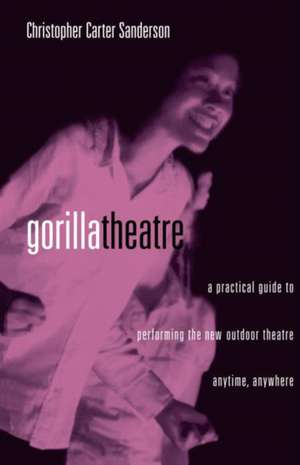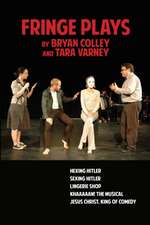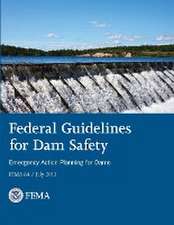Gorilla Theater: A Practical Guide to Performing the New Outdoor Theater Anytime, Anywhere
Autor Christopher Carter Sandersonen Limba Engleză Paperback – 18 iul 2003
| Toate formatele și edițiile | Preț | Express |
|---|---|---|
| Paperback (1) | 277.07 lei 6-8 săpt. | |
| Taylor & Francis – 18 iul 2003 | 277.07 lei 6-8 săpt. | |
| Hardback (1) | 782.79 lei 6-8 săpt. | |
| Taylor & Francis – 18 iul 2003 | 782.79 lei 6-8 săpt. |
Preț: 277.07 lei
Nou
Puncte Express: 416
Preț estimativ în valută:
53.02€ • 55.29$ • 44.07£
53.02€ • 55.29$ • 44.07£
Carte tipărită la comandă
Livrare economică 21 martie-04 aprilie
Preluare comenzi: 021 569.72.76
Specificații
ISBN-13: 9780878301713
ISBN-10: 0878301712
Pagini: 208
Ilustrații: 20 color images
Dimensiuni: 152 x 229 x 14 mm
Greutate: 0.38 kg
Ediția:1
Editura: Taylor & Francis
Colecția Routledge
Locul publicării:Oxford, United Kingdom
ISBN-10: 0878301712
Pagini: 208
Ilustrații: 20 color images
Dimensiuni: 152 x 229 x 14 mm
Greutate: 0.38 kg
Ediția:1
Editura: Taylor & Francis
Colecția Routledge
Locul publicării:Oxford, United Kingdom
Public țintă
Professional Practice & DevelopmentNotă biografică
Christopher Carter Sanderson is founding director of Gorilla Rep. He has taught drama at Princeton and Yale. He lives in New Haven, CT.
Recenzii
"Christopher Sanderson is one of the nation's leading directors of environmental theater and "Gorilla Theater" reflects both his sound theoretical and broad practical knowledge of how to make good, vibrant theater under almost any conditions, anywhere. As such, it's a must read for those who want to take their shows outdoors, into the streets or to the masses." -- New York Times
"When the early-'90s culture wars erupted and public arts funding became scarcer, Christopher Carter Sanderson took his theatre to the people by taking it outside for free. By eschewing the frippery of the playhouse, he pioneered a genuinely individualistic aesthetic that is now brilliantly codified and commented upon in Gorilla Theatre. This is both a practical, step-by-step Gorilla Theatre guide and an unabashed proclamation of artistic beliefs from a singular theatrical voice." -- Leonard Jacobs, Assoc. Editor, Theatre Critic, Back Stage
"As founding artistic director of the Gorilla Repertory Theatre Company, Sanderson knows a thing or two about staging a play in Mother Nature's midst. Recommended for all libraries with active outdoor theater groups." -- Elizabeth Stifter, Brooklyn, NY, Library Journal
"What Sanderson has fashioned in Gorilla Theatre is a training manual for replicating his own work with Gorilla Rep-he calls it a 'new form' of theatre. I hope readers will be inspired by his example and use the book as a tool to create still more 'new forms.'"
." -- Erica Schmidt, American Theatre
"When the early-'90s culture wars erupted and public arts funding became scarcer, Christopher Carter Sanderson took his theatre to the people by taking it outside for free. By eschewing the frippery of the playhouse, he pioneered a genuinely individualistic aesthetic that is now brilliantly codified and commented upon in Gorilla Theatre. This is both a practical, step-by-step Gorilla Theatre guide and an unabashed proclamation of artistic beliefs from a singular theatrical voice." -- Leonard Jacobs, Assoc. Editor, Theatre Critic, Back Stage
"As founding artistic director of the Gorilla Repertory Theatre Company, Sanderson knows a thing or two about staging a play in Mother Nature's midst. Recommended for all libraries with active outdoor theater groups." -- Elizabeth Stifter, Brooklyn, NY, Library Journal
"What Sanderson has fashioned in Gorilla Theatre is a training manual for replicating his own work with Gorilla Rep-he calls it a 'new form' of theatre. I hope readers will be inspired by his example and use the book as a tool to create still more 'new forms.'"
." -- Erica Schmidt, American Theatre
Cuprins
CONTENTS Acknowledgements Foreword by Martin Denton Introduction About Gorilla Repertory Theatre Company, Inc. Gorilla Rep Manifesto 1. Concept and Location Inspiration Read Plays, Shakespeare First List Plays Tour Sites List Sites with Pros and Cons 2. Scouting Organizations That Can Help Rights of Free Speech and Assembly Working Conditions for the Actors and Personnel Mapping the Site 3. Establishing Corporate Culture Observations Responding to Conflicts Running Effective Meetings 4. Casting Ideas and Ideals Respect for Actors and Demands of the Form Enthusiasm for the Form Character Basics and Physical Motion Working in Further Detail Techniques and Scheduling Callback Practices and Forms 5. Rehearsal Techniques Introduction: Use What You Know How Do You See? Respect for the Audience Respect for the Text The Character Meeting: Establishing Individual Communication Scheduling Rehearsal The Three-Phase Technique: Improvisation, Work-Through, and Staging Run-Throughs Adapting Indoor Techniques to Outdoor Uses A Note 6. The Paratheatric Rehearsal Technique Brief Description Early Experiments Scouting and Booking Logistics Schedule Blazing and Establishing Safe Practices Improvisation Suggestions for Day One and Day Two The Bonfire: Metaphor and Practice Night Exercises The Paratheatric Run Examples of Staging Brought Back Integrating Paratheatric Discoveries Variations and How to Invent New Paratheatric Rehearsal Procedures 7. On-site Directing and Operational Practices Practicing Non-Confrontational Conflict Resolution Cut Procedure The Role of the Director in Performance 8. Organizational Approaches Mission Statement and Incorporation Working With Volunteers Publicity: Homemade and Professional Sponsorship Permits, Contracts, and Letters of Agreement Interns Working with Designers Working with an Assistant Handling Crews Trucks and Trucking Notes for the Producer 9. Documentation Practices Documentarian Photo Strategies Video Strategies Archiving: Print, Video, and Mailing Lists 10. Design Issues and Aesthetic Practice Lighting Props Sets Stage Fighting 11. Indoor Environmental or Action Theatre Design Issues Audience Changes and Pressures Examples 12. Moving a Show Feel of the Show Moving A Midsummer Night's Dream: Get Puck! and Other Stories 13. Notes and Observations Dialogue with Criticism Relationship to Academia Sibling Institutions Spirituality























